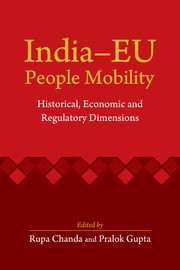Book contents
- Frontmatter
- Dedication
- Contents
- List of Tables, Figures and Boxes
- List of Abbreviations
- Preface
- Acknowledgements
- 1 India–EU People Mobility: Present Status and Policy Perspective
- 2 Economic Linkages and India–EU Mobility
- 3 Indian Diaspora in the EU
- 4 Goans in Portugal: History, Identity and Diaspora Linkages
- 5 Facilitating India–EU Mobility of IT Professionals
- 6 Movement of Indian Architects and Engineers: Prospects and Challenges in the EU
- 7 Mobility of Indian Legal Professionals to the EU: Understanding the EU's Regulatory Regime
- 8 Exploring India–EU Student Mobility
- 9 The Way Forward to a Strategic Engagement
- Contributors
- Index
6 - Movement of Indian Architects and Engineers: Prospects and Challenges in the EU
Published online by Cambridge University Press: 05 January 2016
- Frontmatter
- Dedication
- Contents
- List of Tables, Figures and Boxes
- List of Abbreviations
- Preface
- Acknowledgements
- 1 India–EU People Mobility: Present Status and Policy Perspective
- 2 Economic Linkages and India–EU Mobility
- 3 Indian Diaspora in the EU
- 4 Goans in Portugal: History, Identity and Diaspora Linkages
- 5 Facilitating India–EU Mobility of IT Professionals
- 6 Movement of Indian Architects and Engineers: Prospects and Challenges in the EU
- 7 Mobility of Indian Legal Professionals to the EU: Understanding the EU's Regulatory Regime
- 8 Exploring India–EU Student Mobility
- 9 The Way Forward to a Strategic Engagement
- Contributors
- Index
Summary
Introduction
Over the last decade or more, there has been a change in the pattern of cross-country labour movement from unskilled to high-skilled labour due to the services revolution as well as changes in business models and technological development (Ostrovsky, 2006). The proliferation of trade agreements has also facilitated the movement of high-skilled professionals since such movement has gained greater acceptability under international trade agreements such as the World Trade Organization's (WTO) General Agreement on Trade in Services (GATS). The movement of labour between two countries or between a country and a region depends on a number of factors including skill shortages, differences in salaries and living standards, removal of barriers to labour mobility and employment, among others.
India and the European Union (EU) can be taken as an example of the movement of professionals between developing and developed countries. In recent years, the movement of professionals between these two markets has shown an increase and several factors are responsible for this. These are discussed in detail in the preceding chapters.
Within the high-skilled workforce, one of the most prominent categories is the movement of engineers and architects between the two markets. Engineering and architectural services are considered as knowledge-based and technologyintensive services that require both general and highly specialized skills. According to a report, there is an expected shortage of qualified engineers in Europe and other skilled professionals, including architects. By 2020, 16 million people will be needed to fill high-skilled jobs in the EU, some of which can be obtained from outside the EU. As per another estimate, India has a large pool of engineers and architects, with around 700,000 graduate and postgraduate engineers in 2011 and 49,463 registered architects in 2013. India had the second-largest number of engineers in the world after China. Engineering and architecture are considered to be among the most lucrative professions in India, and the number of students enrolling in the professions has increased manifold. Thus, India is capable of meeting the growing demand for engineers and architects in the EU markets.
The movement of engineers and architects is not a one-way flow. There is a huge need for infrastructure development in India, and there has been an increase in construction activity, which, in turn, has led to increased demand for engineers and architects.
- Type
- Chapter
- Information
- India–EU People MobilityHistorical, Economic and Regulatory Dimensions, pp. 142 - 161Publisher: Cambridge University PressPrint publication year: 2015



